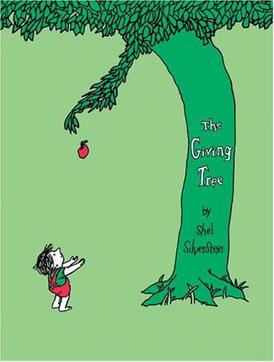The Giving Tree really stresses me out

Shel Silverstein’s The Giving Tree has been around since 1964, and I’ve seen it in basically every library and classroom I’ve ever entered. Every parent I know either has a copy or is, no doubt, about to receive one as soon as their eldest is old enough to sit through a longer children’s story. It’s a wonderful book, but I’ve heard some people interpret it as a story that encourages children to give without boundaries, which is awful. It’s easy for young readers to get the wrong message if they read it on their own because the message is pretty subtle as far as kid’s books go.
The book narrates the relationship between a tree and a boy as the boy ages from a child to an old man. In the beginning, the boy plays with the tree, climbing on her or swinging on her branches. This is great and everyone has an amazing time. Then as the boy ages he begins to ask for more - apples to sell, wood for a house, then more wood for a boat. The tree gives physical parts of herself to the boy. Conspicuously to an adult, the boy never gives anything in return.
Ultimately the tree gives way too much of herself and is left with nothing but her stump. The boy only asks her for stuff and never thinks about what would make the tree happy. The tree realizes this - she admits she wasn’t happy. The only thing that makes her happy is when the boy is spending time with her. The boy and the tree are only happy when the boy wants nothing more than to hang out, both as an old man and as a child.
So much of the book is of the tree giving of herself to the boy that it’s easy to miss that the tree hasn’t been happy for most of her relationship with the boy. The boy isn’t outright mean either. There’s one remark that the tree isn’t happy. The book doesn’t beat us over the head with that main idea as we might see in other children’s books, so it’s easy for a kid to mistake the overall message - that giving too much of yourself to someone you love won’t make you happy - for a message that suggests you should do as the tree does: give and give and give.
Why does the tree keep giving to the boy? Does she hope the boy will come back and hang out like he did when he was a child? Does she want to keep a rift from forming between them? Does she only want to keep the boy from being sad? It isn’t clear, but in any case the tree is inspired to give to her detriment.
I have no idea why any adult would misinterpret the message as one of the joys of giving, but I’ve definitely heard it said both as a kid myself and as an adult. So now I make sure to explain to my kids that the tree wasn’t happy, that the tree was never happy giving that much of herself and that she didn’t even realize it until the boy was much older, and by then it was too late - she’d lost nearly all of herself. The boy was not a good friend to her no matter how much she wanted to be a good friend to him.
I tell my kids we have to say “no” to people like that, as difficult as it may be in the moment. There are no guarantees that anyone will look out for us, so we have to look out for ourselves. If we fall into the trap of living to please others at the expense of our own well-being, we risk living an unhappy life. It’s far better to spend time trying to find people who will care about us as much as we care about them instead of settling for people who will take advantage of us.
It’s sad to cut ties with someone you consider a friend, but sometimes it’s for the best.